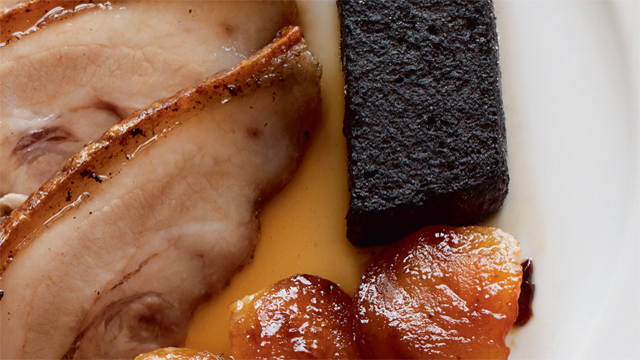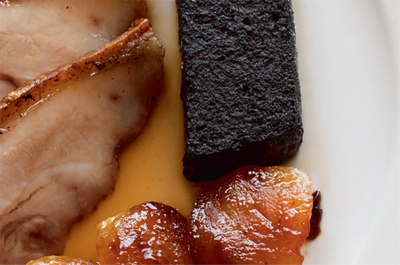New Year pork and black pudding recipe
Simon Hopkinson creates a New Year feast of pork and black pudding - and yes, you can make your own black pudding


I would like to think that, over the past 115 years, there may never have been a recipe for a homemade black pudding in the domestic kitchen within the pages of Country Life. And, if there has, I'm not sure as to whether it would come close to being as good as that which follows.
The recipe is based upon one that the remarkably special cook Jennifer McLagan gives in her most recent book, Odd Bits (Jacqui Small LLP, 2011). What makes the recipe so approachable is there is no need to go to the tricky trouble of filling sausage casings (the thin, but sturdy membrane of a pig's intestine), so forming the traditional look of a black pudding-or, regarding the recipe here, one that is more akin to the French boudin noir.
I make mine in foil takeaway containers, which are perfect. I had never made black pudding until last year, although I had always wanted to. Already having been aware of Miss McLagan's previous books (Cooking on the Bone and Fat) for some time, I just knew that when I saw her black-pudding recipe, it would be a winner and, most importantly, work! The other concern I had was finding a regular source of pig's blood. Admittedly not high on the list of most folk's weekly shop, it may be found if you really want it-the story of my culinary life. By keying in ‘Filipino Shop UK' on an online search engine, you'll find outlets in Manchester, Leicester, Tooting in south London and, curiously, Barrow-in- Furness, Cumbria. I buy mine from an excellent Filipino shop in Earl's Court. The Manila Supermarket (11-12, Hogarth Place, SW5; 020-7373 8305) has a chest freezer with enough blood in it to make 1,000 puddings.
As far as I know, in all cases, the blood will be frozen in plastic containers and ready to use, once defrosted. No removal of difficult clots, for instance, as a saline chemical (sodium citrate) is added to, I believe, help prevent this. However, be warned, this provides all the salt you will need in the black-pudding recipe that follows; I know to my cost, as my first outing with the pudding was inedibly salty and went straight down the sink gobbler. One lives and learns. However, you may further be surprised to know that this frozen blood is blissfully inexpensive at £1.95 (per 350ml).
It's also simple to use, tastes absolutely authentic once cooked and simply does the job-and how very reassuring is that for such an unusual ingredient when introduced to the home cook for the first time? The only other ingredients needed are onions, spice, a touch of cream and fresh pork fat (often called ‘back fat'). You will need a local butcher for this, but it should cost very little; a big London store recently charged me nothing-a happy moment. Because of the exact measure of blood in the plastic container, I've altered the ratio of ingredients in Miss McLagan's original recipe. Also - and because I wanted a smoothly textured pudding - I finally decided to process the mixture (Miss McLagan finely dices her fat). I also use a touch less cream, as well as substituting double for whipping, her original suggestion. But, it is a beautiful recipe, and thank you Miss McLagan for introducing it to me. And for explaining it with such perfect pitch and culinary intellect.
* Country Life New Year subscriptions sale
The black puddings I loved as a boy came from Bury, Lancashire, where I grew up. Close to the Bury Times newspaper offices, there was a front room in a terraced house in Union Street that was used as a ‘shop': an old marble counter, a wooden cash box with a drawer and sheets of newspaper for wrapping up the puddings. The Casewell family made the very finest black puddings, with great chunks of ivory pork fat studded throughout the black congealed blood almost as jewels. They were the most succulent of all Bury puddings and have never since been bettered.
Sign up for the Country Life Newsletter
Exquisite houses, the beauty of Nature, and how to get the most from your life, straight to your inbox.
My late father told me, rather annoyingly, that, when the final owner (a Vincent Ashworth) had to relinquish the premises in 1968, when the street was demolished, the Casewell recipe went with him-perhaps to his grave. The puddings from Chadwick's (‘Original Bury Black Puddings', est. 1929) stall on Bury market-and very nice indeed as they surely are-don't come close, as my memory tells me, to Casewell's rich and fatty links. And, in case you were wondering who decided whose pudding is ‘original', it's thought that Casewell's puddings date back to 1810.
Anyway, the black pudding that you're going to make after reading this - and you will - is as far away from my childhood sweetheart as it's possible to be. I'm not saying it's better - never! - just that the texture and flavour of it are what I now prefer to eat: more Continental, softer, smoother, yet, when cut into thick slices, delightfully cooks up in a frying pan to a crisp membrane without and almost mousse-like, within. Onward...

Homemade black pudding recipe Ingredients 300g fresh pork back fat, chopped into small pieces (not finely diced); about 1cm 350g onions, finely chopped 350ml pig's blood 75ml double cream Half heaped tspn freshly ground white pepper Half heaped tspn cayenne pepper Half heaped tspn quatre épices 25g melted butter
Note: To make quatre épices, mix together 60g freshly ground white pepper, 60g freshly ground black pepper, 15g ground cloves, 30g powdered ginger and 30g ground nutmeg. Mix well and store in an airtight jar Method
Method Put the pork fat into a solid based, generous-sized pot and warm through on a low flame until the fat starts to run. Add the onions, stir together and allow to cook ever so quietly over a low flame, stirring occasionally, until the onions are very, very soft, but not coloured; about an hour should do it. Tip into a bowl to cool to lukewarm. Pre-heat the oven to 170°C/ gas mark 3.
Pour the blood from its bag into a bowl and gently whisk in the cream and spices. In small batches, tip the pork fat and onions into a small food processor and pulse until almost smooth, but with a touch of texture still visible in the mix. Add to the blood mixture and stir together until completely amalgamated.
Take four small foil takeaway containers (about 14.5cm by 12cm by 5cm [about 6in by 5in by 2in]) and brush the insides with the melted butter. Ladle the pudding mixture equally between the three containers and set them in a deep roasting tin. Add enough tap-hot water to the tin until it reaches about two-thirds up the sides of the containers. Loosely cover with a sheet of foil, but don't clamp it around the tin.
Bake for about 40-50 minutes, or until the puddings are lightly bouncy to the touch of a finger. Remove from the baking tin and leave to cool to lukewarm, then put on the lids and clamp the edges to seal. These puddings keep very well in the fridge for up to one week For the roast pork Serves 4
Ingredients 1.5kg belly pork, the skin scored with a sharp knife (I use a Stanley knife) Freshly ground white pepper Fine salt
Method Begin the recipe the day before. Fill a kettle and boil. Lay the belly pork on a cooling rack over a deep tray, skin side uppermost. Slowly pour boiling water over the skin until the kettle is empty and the lines of scored skin have become visibly separate.
Turn the belly pork over onto a large tray and rub the meat with pepper, working it in well with your fingers. Now, turn it over and rub the salt into the skin. Allow the skin to dry out in a cool place, preferably overnight; in the fridge, if you must. Pre-heat the oven to 230˚C/ gas mark 8.
Take a deep roasting tin and, over this, suspend a cooling rack and place the pork on it, skin side up. Slide into the oven and roast for 20 minutes. Now, turn the temperature down to 180˚C/gas mark 4 and cook for a further 30-40 minutes.
For the apples Ingredients
4 sweet apples, peeled-Cox's, preferably, or russets. Golden Delicious, if you must 75g butter 2tbspn caster sugar Squeeze of lemon juice Method
Cut the apples in half from top to bottom. Using a teaspoon or, even better, a melon-baller, scoop out the central part, its seeds, and also extra core at either end. Cut into quarters. Melt the butter in a solid, roomy frying pan over a moderate heat, then sprinkle in the sugar. Stir together until amalgamated, then add the apples, rounded side down.
Allow the apples to quietly colour beneath, then turn over and continue cooking until the apples are soft within and gorgeously golden without; about 20-25 minutes cooking time in all.
* Follow Country Life Magazine on Twitter
Country Life is unlike any other magazine: the only glossy weekly on the newsstand and the only magazine that has been guest-edited by HRH The King not once, but twice. It is a celebration of modern rural life and all its diverse joys and pleasures — that was first published in Queen Victoria's Diamond Jubilee year. Our eclectic mixture of witty and informative content — from the most up-to-date property news and commentary and a coveted glimpse inside some of the UK's best houses and gardens, to gardening, the arts and interior design, written by experts in their field — still cannot be found in print or online, anywhere else.
-
 The big reveal: A first look at Country Life's RHS Chelsea Flower Show stand
The big reveal: A first look at Country Life's RHS Chelsea Flower Show standInterior designer Isabella Worsley reveals her plans for Country Life’s ‘outdoor drawing room’ at this year’s RHS Chelsea Flower Show.
By Country Life
-
 Schreiber House, 'the most significant London townhouse of the second half of the 20th century', is up for sale
Schreiber House, 'the most significant London townhouse of the second half of the 20th century', is up for saleThe five-bedroom Modernist masterpiece sits on the edge of Hampstead Heath.
By Lotte Brundle